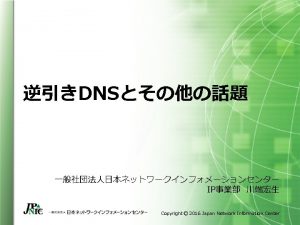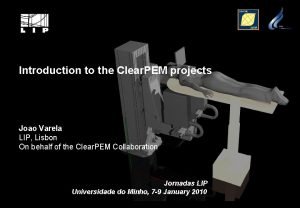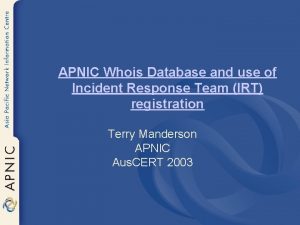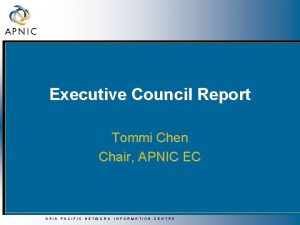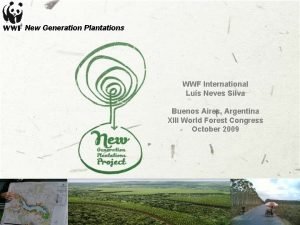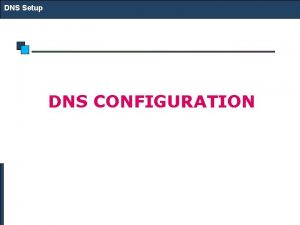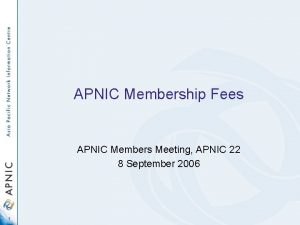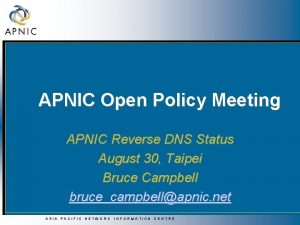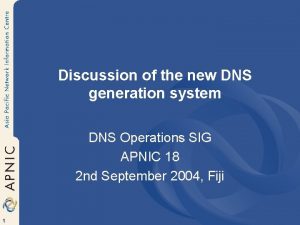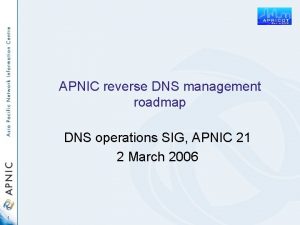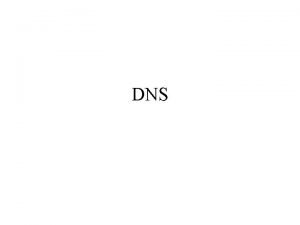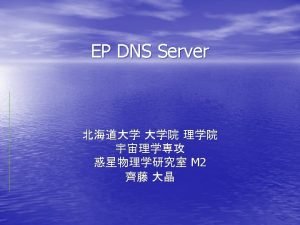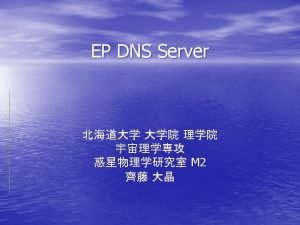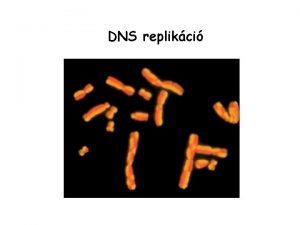The new APNIC DNS generation system Previous System















- Slides: 15

The new APNIC DNS generation system

Previous System • Direct access to backend whois. db files – Constructed radix tree in memory from domain objects – Walked tree in order to derive • Zone files for changed zones • • • Change was defined by changed: field in domain object being current date Zone files pushed to DNS via RSYNC Secondary zones controlled by PEERS files, p 2 n. pl script.

Problems • Monolithic solution – Hard to add new options • New database changed data format – backend SQL in v 3 would require recoding anyway • NS reload slow, buggy – Too many periods with only one functional NS

Problems contd • Secondary management intertwined with primary function – Needed better functional separation – Bind problems • master / secondary / master • Uneccessary DNS changes – SOA incremented for descr, nic-hdl changes

Goals for a new production system • Make zone update more efficient • Allow addition of new features • Separate secondaries from main process • Simplify zonefile production

Goals (continued) • Make zone update more efficient – • Can support dynamic processes when viable Allow addition of new features – – DNSSEC zone signing LAME delegation processing NOTIFY based push to DNS from master SOA serial increment on real change, not from changed: flag

Goals (continued) • Separate secondaries from main process – • Improves DNS stability Simplify zonefile production – – staged pipeline of simple phases Use UNIX tools

Simple Pipelined process Easy to add parallel passes (eg to merge external data sources)

Separated secondary processes • Not based on whois domain records • Separate servers • Better records management on prime source contacts • Improved management processes • Can offer scaleable secondary services – To cc. TLD, AP-community, members

Integrating the ERX process • ARIN ERX transfer process: – fetch of (partial) zone contents – Production of matching file for ARIN, RIPE to fetch from APNIC • Staged pipeline highly amenable to both local and ERX processes • Permits normal whois activity for enduser management of domain object.

Implementation timeline • April identify need for new process – Discuss DNS generation with other RIR, IETF dnsops people • June ERX discussions Toronto – Implementation of treewalk->flatfile • July – Full DNS zone generation • August – Deployment

Issues • Time between ns 1, ns 3 restart – Needed to be kept to a minimum • soa serial/contents mismatch – Ensure at least one NS was functional at all times • Check in-addr. arpa resolution offsite • Check non-reverse-tree DNS status – cc. TLD secondaries, RIPE/ARIN secondaries

Interesting side-effects • DNS lookup times in reverse are faster for clients when no cached data – Less recursion to find authoritative answer • NXDOMAIN is faster – Less noise on the wire • Top level /8 serial increments more often – We can adjust cache/ttl settings to tune

Traffic Measurements DNS cutover, Aug 19

Post-Upgrade behaviour • • • DNS update is faster, simpler Less delay from whois -> DNS Overall DNS traffic dropped More consistent load share JP/AU US/Europe now fully serviced APNIC can deploy new services – Pre-creation of domain objects – LAME checks
 Apnic dns
Apnic dns Debogon project
Debogon project My.apnic
My.apnic Animal anthony apnic
Animal anthony apnic Apnic whois
Apnic whois Geoff huston apnic
Geoff huston apnic Apnic ec
Apnic ec First generation antipsychotics vs second
First generation antipsychotics vs second From generation to generation we worship you
From generation to generation we worship you New product development process of cadbury
New product development process of cadbury Define new entry in entrepreneurship
Define new entry in entrepreneurship Teachers the new generation will be your devotion
Teachers the new generation will be your devotion New joshua generation
New joshua generation New generation wwf
New generation wwf New generation devices
New generation devices Generation new millenium
Generation new millenium
